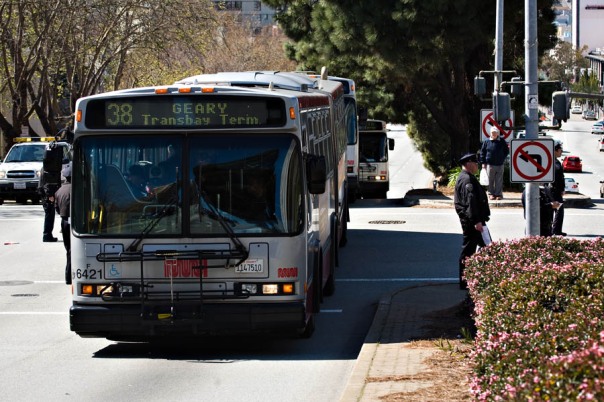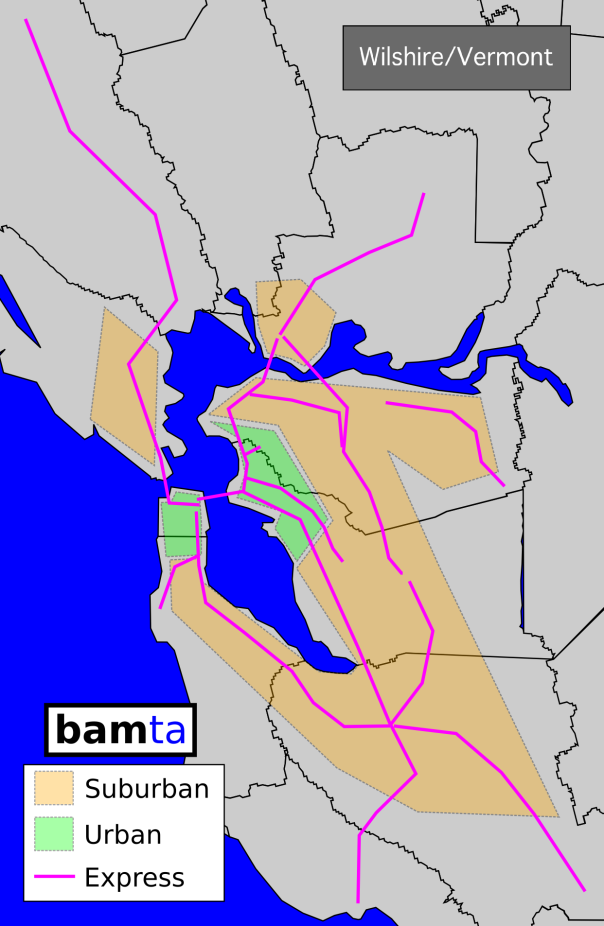Category Archives: bamta
The Bay Area’s Fragmented Transit Operators
In the United States, public transit as a mode of travel is generally slower and less convenient than driving. Sixty years of automobile-oriented development and massive subsidies for freeways, parking and fossil fuels have made driving the predominant mode of transportation. Programs like the Federal Transit Administration’s New Starts have made transit more viable for many, but the operational and funding structures of transit agencies often further complicate trips on transit.
The San Francisco Bay Area is the most fragmented transit market in the country. With a population of nine million and very dense development concentrated in linear patterns due to geography, the Bay Area should be a great place for transit. Rail ridership on all systems is around 600,000 per day and bus ridership on all systems is around 1.5 million riders per day. Those numbers are impressive, but the fragmentation of transit operators greatly inhibits longer trips, causes cutthroat competition for funding and is grossly inefficient for capital expenditures.
Take for example Contra Costa County in the East Bay. Four bus agencies, AC Transit, County Connection, WestCAT and Tri-Delta Transit cover the largely suburban county, all of which but AC Transit provide very infrequent service and serve a small amount of riders. Their limited service areas and low budgets limit the potential for more regional routes. For example, a rider in Hercules traveling to UC Berkeley would need to take a WestCAT bus that runs once an hour to El Cerrito Del Norte BART, take BART to Downtown Berkeley then take AC Transit 51A to campus. This trip would take over one hour by transit, cost nearly six dollars each way and only be possible once an hour. Merging transit agencies could coordinate schedules, cross subsidize suburban bus service with urban bus or rail revenue and consolidate administrative and purchasing departments to cut costs.
A “super” transit agency for the Bay Area would look something like New York’s MTA or Chicago’s RTA. In this hypothetical situation, let’s call the agency bamta (Bay Area Metropolitan Transportation Agency). bamta would absorb the core portions of AC Transit (Oakland-Berkeley-Richmond) and all of SF Muni’s bus operations into bamta Urban Bus Division. Suburban portions of AC Transit (in the Fremont area), WestCAT, Tri-Delta Transit, Vallejo Transit, County Connection, WHEELS, Marin Transit Local Service, SamTrans and VTA would all become bamta Suburban Bus Division. Finally AC Transit Transbay Service, Golden Gate Transit, Baylink, Dumbarton Express and all express routes of WestCAT, SamTrans and VTA would become bamta Express Bus Division. This substantial consolidation would centralize planning, coordinate route schedules, provide service across current service boundary lines and allow collective bus purchases to cut costs.
Rail operations in the Bay Area are also managed by far too many agencies with diverging goals and incompatible scheduling. An electrified Caltrain and BART could be combined into bamta Rapid Transit Division. SF Muni’s Metro System and VTA light rail could be merged into bamta Light Rail Division. Finally, ACE, SMART, Capitol Corridor and Caltrain diesel operations could become bamta Commuter Rail Division.
bamta could also gain control of the Bay Area’s numerous toll bridges and directly use revenues for transit operations. The Golden Gate Bridge Highway and Transportation District and Bay Area Toll Authority would combine into bamta Highways and Bridges.
Under such a drastic plan, the Bay Area’s current (and ineffective) metropolitan planning organization, MTC, would no longer be needed and could be disbanded. bamta would assume MTC’s duties as MPO. bamta would also assume BART’s previous role as a special district, giving it the ability to tax the nine counties in which it would operate.
With a dedicated source of funding, in the form of a sales or payroll tax, current disasters like the 61 million dollar budget deficit at Caltrain would be avoided. Transit through bamta would be more convenient and coordinated, funding would be directed at a single body instead of over 15 agencies and administration could be consolidated. Think of it: instead of 15 Human Relations Departments or 15 Legal Departments, there would only be one and so on.
Less competing government agencies, a more streamlined approach to transit planning and operations and a unified brand for transit in the Bay Area would vastly improve transit’s ability to compete with the automobile. Politically, this agency would hold clout equal to the Los Angeles County Metropolitan Transportation Authority in statewide matters of transportation funding, giving Bay Area residents a heavier hand in State politics.
You will hear more of my bamta idea in posts to come, especially about a unified rail system and its benefits. I’ll also finally get to my third post about the Los Angeles Westside Subway Extension tomorrow.
Politics and the follies of the California State Government will likely prevent any consolidation of transit agencies, let alone one as drastic as my proposal. Alas, one can dream.



